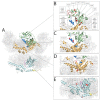Multisystem Proteinopathy Due to VCP Mutations: A Review of Clinical Heterogeneity and Genetic Diagnosis
- PMID: 35741724
- PMCID: PMC9222868
- DOI: 10.3390/genes13060963
Multisystem Proteinopathy Due to VCP Mutations: A Review of Clinical Heterogeneity and Genetic Diagnosis
Abstract
In this work, we review clinical features and genetic diagnosis of diseases caused by mutations in the gene encoding valosin-containing protein (VCP/p97), the functionally diverse AAA-ATPase. VCP is crucial to a multitude of cellular functions including protein quality control, stress granule formation and clearance, and genomic integrity functions, among others. Pathogenic mutations in VCP cause multisystem proteinopathy (VCP-MSP), an autosomal dominant, adult-onset disorder causing dysfunction in several tissue types. It can result in complex neurodegenerative conditions including inclusion body myopathy, frontotemporal dementia, amyotrophic lateral sclerosis, or combinations of these. There is also an association with other neurodegenerative phenotypes such as Alzheimer-type dementia and Parkinsonism. Non-neurological presentations include Paget disease of bone and may also include cardiac dysfunction. We provide a detailed discussion of genotype-phenotype correlations, recommendations for genetic diagnosis, and genetic counselling implications of VCP-MSP.
Keywords: VCP; amyotrophic lateral sclerosis; dementia; genetics; genotype-phenotype correlation; multisystem proteinopathy; myopathy.
Conflict of interest statement
The authors declare that they have no competing interests to report.
Figures

References
Publication types
MeSH terms
Substances
Grants and funding
LinkOut - more resources
Full Text Sources
Medical
Research Materials
Miscellaneous

